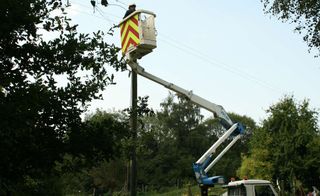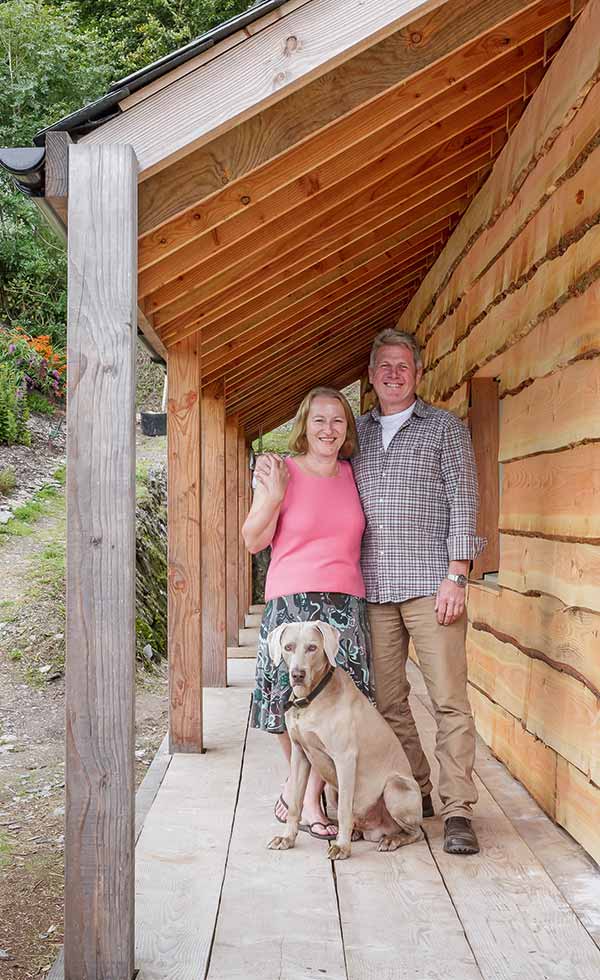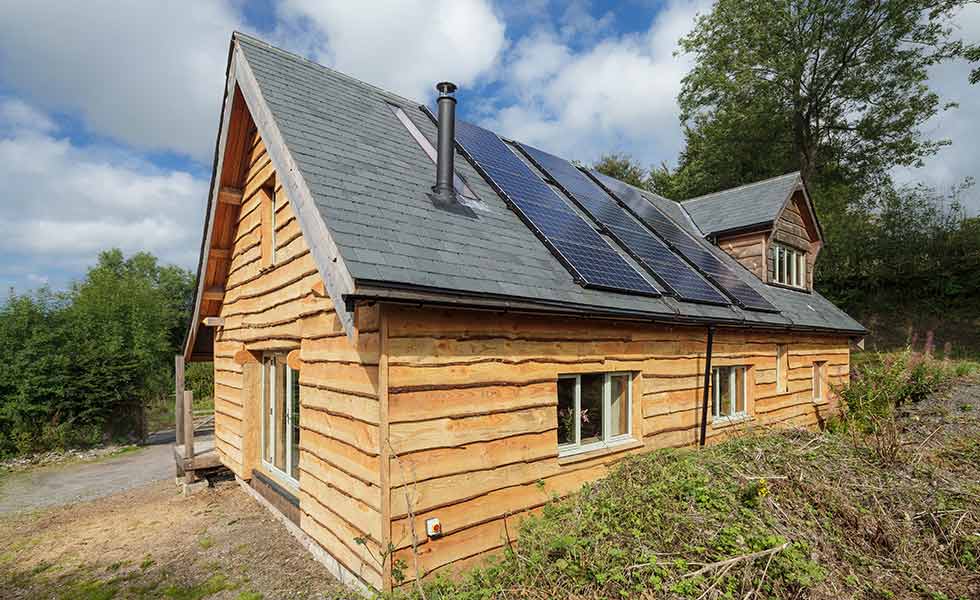How To Get Electricity To My Land

It is definitely beneficial to have mains electricity on your site equally early on as possible (although y'all can manage for some time with generators or manus tools if this is non possible). But how exercise you lot go about setting this upwardly?
How do I get an Electricity Connection?
Apply for a quotation for a new connectedness from the distribution network operator (DNO) responsible for electricity in your geographical area equally soon as you have plans of your proposals, including a site and location plan. The application process usually involves filling out an online form.
Connectedness is not cheap, and it's best to budget for information technology as early on as possible. The quotation will be time limited, too, then be aware of the lead times that are required. Nothing volition happen until you pay for the supply in full. Once yous practise, aim to stick to the DNO's timetable.
One time you have a quote you lot will be given the name of the person who will be handling your project. Make friends with that person. They may be able to smooth the passage of the contract and help with transition from distribution to supply company where liaison is necessary.
How Much will it Price?
It's very difficult to predict equally each site, even on the same street, will exist different. You demand to be aware of your state of affairs before estimating the costs involved. Take the following examples:
Site one is a new bungalow on an unmade lane on the outskirts of a hamlet where the supply is overhead and the pole is within the plot. The supply is brought downward the pole and and then routed underground in trenches dug past the cocky builder. This could cost around £450.
Site ii requires a unmarried phase supply off the master line which already runs over the cocky builder's plot. The piece of work involves installing a new pole with a mounted transformer (on the self builder'southward own land) and then running the cable 35m to the house. The quotation given is £7,000.
Site three requires supply in a rural position, entailing a 60m road dig with the distribution company digging as far every bit the purlieus. This could price upwardly to £10,140.
Which DNO Should I Approach for a New Connection?
The United kingdom is divided into regions, with various DNOs responsible for maintaining and supplying electricity in these areas. The companies are:
- Scottish & Southern Electricity Networks (opens in new tab), covering northern Scotland and the Islands as well as much of primal southern England
- SP Energy Networks (opens in new tab) ,roofing central and southern Scotland, Merseyside, Cheshire, north Wales and northward Shropshire
- Northern Ability Filigree (opens in new tab) ,covering Northward East England and Yorkshire
- Electricity North West (opens in new tab), roofing North West England
- Western Power Distribution (opens in new tab) ,roofing the East and West Midlands, South Wales and Due south Westward England
- UK Power Networks (opens in new tab), covering Eastern England, London and South East England, including the Island of Wight
- Northern Ireland Electricity Networks (opens in new tab) ,roofing Northern Ireland
The names of these companies practice not necessarily reflect the regions or areas of their operation. Yous can see maps of their operating areas at nationalgrid.com (opens in new tab). Check which DNO you come under, every bit at that place are bound to be deadline anomalies.
Practice I Need a Wayleave?
The network companies have the right to cross public highway country to bring you your supply, just they don't have the right to cantankerous private land or land in the buying of public bodies including:
- Forestry Commission
- Network Rail
- British Waterways
For that, a wayleave (opens in new tab) is required and in virtually cases permission will entail payment of a ransom. The distribution company will quote you for their piece of work only will not and cannot carry out that work until the wayleave is agreed and paid for by you.
The amount paid for a wayleave will depend largly on whether in that location are feasible alternatives to crossing state owned by other people. In the worst case, bar a total refusal, the amount required tin can be as much as one third of the uplift in value due to the wayleave making the plot suitable for development. Be aware that y'all cannot force or require a individual private, owner or visitor to do business with you.
Bringing the Supply to Site
Don't Lose the Fuse
Some companies leave the fuse out and loose in the box and then that in that location is no live terminate. You need to know where that fuse is, as information technology may cause delays if the supply visitor has to source one when they come to install the meter.
The DNO will supply a quote for bringing the supply to the meter position of your property. It will require that its supply terminates in a lockable box or meter box that yous supply, which can be mounted on a stout pole or built into a wall in the eventual position where it will remain.
If the supply is coming downward or across highways, or other land, information technology is normal for the quotation to include the road dig element as far every bit the boundary. Withal, y'all will be responsible for excavation whatever necessary trenches within your site to the meter position. The DNO will supply and lay the cablevision from its primary to the meter box, where it will finish at a 100amp fuse, which is fixed in the box.
Overground or Clandestine?
If the mains in the street run overhead, the distribution company may choose to bring the supply to a new pole on your purlieus. From here it will come up down the pole and run undercover to your belongings. This may be cheaper than a route dig, but it's not always possible or user-friendly, and levels and heights may mean that it is not possible to cross a highway.
To brand savings, yous can carry out the excavations yourself if you, or your contractors, have the necessary insurance (opens in new tab). Normally there's not much saving to be made with a road dig (you'll demand to employ a Highways-approved contractor), but it can be advantageous to dig beyond, say, Forestry Commission land where in that location are no traffic issues and the reinstatement is straightforward.
What practice the DNOs Provide?
The DNOs will usually provide the cable, and accoutrements, from the mains to the 100amp fuse at the meter position, and will decide the cable size. More often than not, if the supply is having to run more 40m, or if more than 1 belongings is to be supplied, they volition have to move to a thicker 80mm cable.
The cocky builder can opt to install ducting in the trenches within their site but this must conform strictly with the requirements of the DNO. For 25mm cable, this is purpose-made 100mm black ducting. All ducting and cables must take alert record laid over them prior to backfilling.
Where Should the Meter Box Go?
The best position for a meter box is on or near the front of the business firm and then that it tin can exist read without the need to enter your private amenity space. They are cruddy, though, so if you tin get it around the side, but all the same accessible, that is oft better. Congenital-in boxes, which tin be painted so that they don't stand out so much, are preferable to surface-mounted boxes.
The rise of the smart meter ways that the demand for the traditional meter box may die abroad soon anyway.
How Do You Go Ability?
You will demand to contact a supply company who will arrange for a meter to be fitted. The process for a temporary supply is that the supply company installs a meter and connects this to a temporary consumer unit within the box, which your electrician will have installed, leaving tails.
These tails are then continued to the meter by the meter installers and they, in plow, connect the meter to the supply via the 100amp fuse left by the DNO. The temporary consumer unit can and so provide a supply to a power socket or sockets located in another lockable box.
The supply can just be re-routed into the chief consumer unit of the business firm once the electrical installation is consummate and certified by a qualified and Role P registered electrician.
Who are the Supply Companies?
The supply companies are completely different from and have trivial or no association with the DNOs. These are generally considered the 'big six':
- British Gas (opens in new tab)
- EDF Energy (opens in new tab)
- Due east.On (opens in new tab)
- Npower (opens in new tab)
- Scottish Power (opens in new tab)
- SSE (opens in new tab)
It is very difficult to get some of the 'big six' to install a meter as their systems are geared towards premises with pre-installed meters. Therefore, information technology can pay to deal with i of the many smaller or contained suppliers who are often a lot more than flexible and helpful. In that location are lots out in that location, then practice some inquiry and read others' reviews when choosing a supplier from outside the 'large six'.
Can I Go Off Grid?
Yes. A few cocky builders do cull to become totally off filigree, using renewables instead of electricity from the National Grid, including Linda and Justin Tyers (below). They self built a straw bale and timber house (opens in new tab) in Exmoor National Park for just £67,000.

The couple are now virtually gratuitous of utility bills. "It was going to exist very expensive to connect to electricity, then we decided to become off grid," says Justin. PV panels generate the couple's electricity, with a large banking company of batteries providing power at night and on duller days. In that location's a generator too, which Justin bought for £iii,000 early on in the project to supply electricity to the site. This now offers a redundancy solution should they ever need it.
An Esse woods-fired range is used for cooking but also supplies hot water and space heating when it's running in the wintertime. In the summer months, an immersion heater supplies hot water and the couple employ a LPG hob. There's as well a woodburning stove which provides additional heat. What'due south more, when the PV panels charge the batteries to 100 per cent, the arrangement automatically turns the immersion heater on — the surplus energy heats the water.

The couple admit that off-grid living (opens in new tab) does require some consideration. "The key really is to do those power-hungry things – running the washing machine, power tools, the immersion heater, and so on – on a sunny day and the panels will accept care of the power needed in existent fourth dimension," says Justin.
Get the latest news, reviews and product advice straight to your inbox.
David is one of the U.k.'s leading self build and plotfinding experts, and a serial self builder who has been building homes for 50 years. The author of Building Your Own Abode, David spent decades as a speaker and practiced at cocky build exhibitions such as the Homebuilding & Renovating Show. He has recently finished his fourteenth cocky build project.
Source: https://www.homebuilding.co.uk/advice/bringing-electricity-to-site

0 Response to "How To Get Electricity To My Land"
Post a Comment